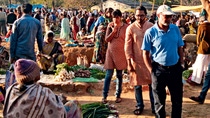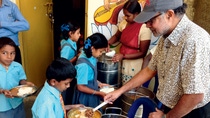Kim jesteśmy
Sowing the seeds of the Second Green Revolution

The world’s population is set to reach 9 billion by 2050. Can our food system provide everyone with enough food for a healthy life, while maintaining a healthy environment? Professor Prabhu Pingali, Ph.D., director of the Tata-Cornell Agriculture and Nutrition Initiative, is cautiously optimistic but says sustainable intensification of agriculture and collaborative policymaking will be essential.
Creating Chemistry: There’s widespread interest today in the sustainability and efficacy of the global food system. How does this level of attention compare to the early 1980s, when you were starting your career?
Professor Prabhu Pingali, Ph.D.: When I started to work on agriculture and food in the early 1980s, almost all the emphasis was on staple grains – rice, wheat and maize – and the emphasis was very much on increasing overall production. There was very little understanding at that time of the overall food system and of the importance of building up a diversity of food available to consumers. That’s been the big change over the last three decades: moving away from this focus on staples to looking more broadly at the food system from farm to plate.
In 2013, you became the founding director of the new Tata-Cornell Agriculture and Nutrition Initiative, which focuses on finding ‘agricultural pathways out of poverty and malnutrition in rural India’. Do you think the architects of the first Green Revolution would have expected such an initiative still to be necessary today?
Yes, I’m sure they’d be surprised. The Green Revolution was focused very much on rice and wheat, and on self-sufficiency. By the early 1980s, India for example was food self-sufficient. But then you had this period between 1985 and 2005 that I call the lost decades for agriculture, when governments in India and more generally across the developing world stopped investment in agriculture because they thought they’d solved the problem. That’s part of the reason why we still have high levels of rural poverty.
Also, government policy never got around to looking at the importance of a more diversified diet, so investments in vegetables and livestock lagged behind the main staples. You have this anomalous situation in a country like India where you’ve seen rapid economic growth but very high levels of malnutrition, especially among the poor. The institute was set up as a way to address this anomaly and figure out how to bring agriculture and nutrition back together again.
“We’ve got the technologies, the land resources, and if government policies are focused on eliminating hunger and malnutrition, then we can see that change happen.”
Professor Prabhu Pingali, director of the Tata-Cornell Agriculture and Nutrition Initiative
By 2050, the global population is projected to increase by about one third, which the UN Food and Agricultural Organization has said requires a 70% increase in food production. How can we achieve this sustainably?
I think we can do it and do it sustainably. For agriculture today in many developing countries, yield levels are significantly lower than their potential, and that gap needs to be filled. If the focus over the next two to three decades is on intensification in areas where agricultural production is currently taking place, we will see overall increases in productivity without having to expand land areas. And sustainable intensification is possible: One can look at various options for improving efficiency in fertilizers and water, for example. Intensification and sustainability work hand in hand.

Meanwhile, there is also a huge problem of food waste. In developing countries, this occurs early in the supply chain, with crops lost before they can be eaten or sold. How do we address this?
Much of the farm waste in developing countries takes place at harvest and post-harvest level. I think the way to solve these problems is for significant private sector investment to take place in these areas. This can be small-scale, with improved bags for storing grain, for example, to prevent insects from attacking the grain. One can also look at cold storage systems and at improved transport systems. But many of these need to be done in a way that’s focused on small farm ers. Governments can play a big role in promoting small-scale enterprises for post-harvest operations.
Last year’s Nutrition for Growth summit in London delivered a commitment from rich countries to double spending on global nutrition from about $418 million to $900 million a year between now and 2020. How would you like to see that money used?
I think this should be seen as an opportunity to focus sharply on the rural poor, on rural malnourishment and look at ways in which we can address that problem. Let’s focus on smallholder productivity growth, let’s look at the role of bio-fortified crops in addressing immediate nutrition needs for these populations. And let’s look at opportunities for diversifying their production systems. If we can bring all these together, along with complementary investments in water and sanitation, then I think we can make a big leap forward in improving nutrition security.
How significant are some of the recent advances in genomics and crop improvement, particularly in achieving bio-fortified varieties (such as vitamin-A enriched cassava) and improved tolerance to climate stress and water salinity?
We’ve seen some remarkable new varieties because of genomic advances: drought-tolerant varieties and, of course, bio-fortified varieties. But the amount of material coming out of genomics in terms of finished varieties is still quite small. One of the main reasons for that is that public perception is quite neg ative about GM crops, and that perception carries over to genomics because public understanding of the difference between the two is not great. That’s a problem. The scientific community hasn’t been able to make the case that genomics per se is an important and independent innovation relative to GM crops. That perception needs to be addressed.

How can we best ensure that these improved crop varieties are actually made accessible to those who could most benefit from them?
In the early years of the Green Revolution, there were these networks of breeders set up around the world, and these networks were able to share genetic materials and improved varieties freely. Breeders were able to test improved material in their own environment and then have it released in their own countries. It was a major operation. By the 1990s many of these networks stopped working. Public support wasn’t there, and that’s been a big problem in being able to disseminate new modern materials. If there’s a way to come back to those types of breeding networks that can allow breeders to share material freely that would be a big step forward.
Technologies such as SMS and GPS have become widely available, with even the poorest farmers having access to cell phones. How can such technologies be used to improve food security and nutritional outcomes?
Certainly on price information, cell phones are filling a gap. Farmers are checking market prices and responding to that. That’s an easy win. The harder issue is the realtime crop management advice that can come from the use of smartphones. There are lots of experiments around that, such as farmers taking pictures of a disease on a plant and sending that picture to a lab and getting a response. The real challenge is scaling up. How do you turn these into commercial small enterprise operations that people benefit from? There are few places in smallholder agriculture where that’s happening, making small businesses of information services is the only way to sustain these operations.
“Where I see real positive change happening is in the promotion of women’s self-help groups.”
Professor Prabhu Pingali, director of the Tata-Cornell Agriculture and Nutrition Initiative
Research by the World Bank tells us that putting food and income into the hands of women is the best way to improve public health, because women are more likely to invest in their children’s health and nutrition. How do we unlock the productive capacity of women farmers?
Women farmers are crucial for ensuring overall agricultural productivity growth and food security. Where I see real positive change happening is in the promotion of women’s self-help groups. I see it in India and I’m also beginning to see it in other parts of the developing world. Women’s self-help groups came up initially as microfinance groups, but over time they have evolved to take on broader chal lenges around smallholder agricultural productivity, overall rural development, and rural governance. It’s that platform that I think we need to focus on. We need to fig ure out a way in which, rather than doing lip service about gender, we look at how rural women are transforming themselves and figure out a way to work with them and build on that platform for creating change.
Agriculture can be a driver of growth, but many young people in developing countries are migrating to cities. How can we ensure that agriculture remains viable and attractive to younger generations?
The draw of urban centers will continue. In my view, creating opportunities for rural entrepreneurs is probably the best way to go: rural entrepreneurs around the provision of agricultural services, information systems and post-harvest operations. If you can do that, then you create an opportunity for young people to earn enough to have a good life in rural areas. There’s very little government investment in making such rural enterprises grow and flourish.
Do you think mankind will see an end to hunger and malnutrition within the next decades?
It’s a question of can we, or will we? I think we definitely can. We’ve got the technologies, the land resources, and if government policies are focused on eliminating hunger and malnutrition, then we can see that change happen. Will we? I’m not as confident. You still have a strong urban bias to government policymaking, and there is little coherence between domestic policies and international policies. Unless you get the various policymaking groups to sit together and focus on a common goal of eliminating hunger and malnutrition, we’re not going to see it happen. But we have the means. We can make it happen.

